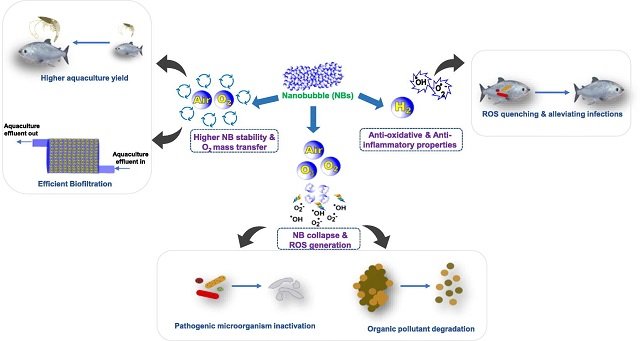Researchers from the National Taiwan Ocean University, Indonesia Defense University, and King Abdulaziz University published a review highlighting advances in recirculating aquaculture systems (RAS) for the cultivation of Penaeus vannamei shrimp and their effects on crop yields.
RAS in shrimp cultivation
The aim of recirculating aquaculture systems is to provide a suitable environment for intensive production of aquatic organisms, through continuous operation and uniform flows of water and oxygen.
RAS has the advantage of being environmentally friendly, adaptable, predictable, hygienic, and highly efficient in water usage.
The benefits of RAS highlight the good potential for developing white shrimp cultivation technology by improving quality and productivity.
Some studies have reported that recirculating systems in aquaculture can be applied for super-intensive cultivation of white shrimp at an optimal density of 500 PL/m3, allowing productivities of up to 5.20 kg/m3, within a cultivation period of 84 days.
However, the application of RAS technology still faces some challenges, such as energy efficiency.
RAS and hybrid RAS
RAS has been demonstrated to be effective when combined with existing aquaculture technologies such as constructed wetlands (CW), biofloc, and multitróphic aquaculture.
Several studies have determined the potential of combining RAS and multitróphic aquaculture, in which water is progressively enriched with nutrients generated by shrimp cultivation.
Stay Always Informed
Join our communities to instantly receive the most important news, reports, and analysis from the aquaculture industry.
The performance of RAS technology in shrimp farming is often evaluated by comparing its economic availability and efficiency with other approaches.
Growth performance
Growth performance is one of the parameters used to determine the effectiveness of RAS application in shrimp aquaculture. Various aspects of growth can be evaluated to determine successful performance.
The application of RAS has positive impacts on the growth of white shrimp. In general, its implementation allows for maintaining good water quality, followed by optimal and efficient use of food, as well as other crucial factors such as stocking density, water quality, and size of the rearing environment.
One of the main challenges in RAS for shrimp farming is determining the stocking density to achieve the highest productivity.
Shrimp survival rate
Stocking density is one of the most crucial factors behind the survival rate in RAS systems. High stocking density has a high correlation with water quality; RAS systems can provide a stable and controlled environment, especially in terms of water quality, to ensure maximum survival.
Previous studies have shown that modifying recirculating aquaculture systems, in combination with biofloc technology, using macroalgae as a biofilter, ozonation, and low salinity conditions, can improve shrimp survival rates.
Disease control
One study reported that shrimp cultivation in an RAS system modified with appropriate ozonation dosages can control the abundance of Vibrio parahaemolyticus.
Likewise, the pathogen load in shrimp larviculture can decrease with the use of ozone, which benefits shrimp survival and growth.
Other studies established that the RAS system can manage the bacterial community in the water to reduce the abundance of pathogenic bacteria.
Conclusion
Recirculating aquaculture systems (RAS) provide an alternative when environmental regulations, diseases, soil availability, salinity, temperature, and water availability hinder shrimp cultivation.
In this sense, the researchers conclude that the RAS system can be the first choice for white shrimp cultivation to achieve sustainability.
Contact
Muhammad Browijoyo Santanumurti
Department of Marine Biology
Faculty of Marine Sciences
King Abdulaziz University,
Jeddah, 21589, Kingdom of Saudi Arabia
e-mail: m.browijoyo.s@fpk.unair.ac
Reference (open access)
Nugraha, M., Dewi, N., Awaluddin, M., Widodo, A., Sumon, M., Jamal, M., Santanumurti, M. Recirculating Aquaculture System (RAS) towards emerging whiteleg shrimp (Penaeus vannamei) aquaculture. International Aquatic Research, 2023; 15(1): 1-14. doi: 10.22034/iar.2023.1973316.1361
Editor at the digital magazine AquaHoy. He holds a degree in Aquaculture Biology from the National University of Santa (UNS) and a Master’s degree in Science and Innovation Management from the Polytechnic University of Valencia, with postgraduate diplomas in Business Innovation and Innovation Management. He possesses extensive experience in the aquaculture and fisheries sector, having led the Fisheries Innovation Unit of the National Program for Innovation in Fisheries and Aquaculture (PNIPA). He has served as a senior consultant in technology watch, an innovation project formulator and advisor, and a lecturer at UNS. He is a member of the Peruvian College of Biologists and was recognized by the World Aquaculture Society (WAS) in 2016 for his contribution to aquaculture.




